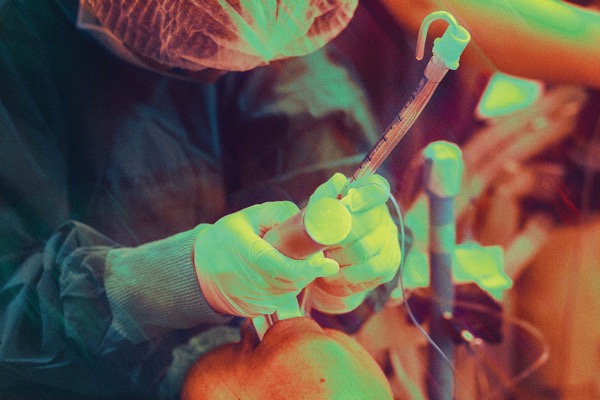[Re: “The Frost Series,” October 2023, page 28]

Dear Dr. Sibert, I don’t understand a repeated attempt to ventilate by mask when such has been difficult in the past. Why not go straight to a laryngeal mask airway (LMA)? If I can’t ventilate with a face mask, that’s what I’ll do anyway, so why waste precious apnea time? Furthermore, my hands are tied up when ventilating via the face mask. The goal in that case is to continue the anesthetic, ventilating the patient with the volatile agent using pressure-cycled ventilation, leaving me with free hands and plenty of time to ponder, “What’s next?”
Recently, my colleagues and I had the challenge of a known difficult intubation case where the patient’s prior trip to the OR for a rotator cuff repair resulted in a soft palate perforation after a failed, hurried intubation attempt by a CRNA with a GlideScope (Verathon). Incredibly, the patient returned for a repeat attempt after the surgeon canceled his case. I insisted on performing the airway management myself. The patient was very difficult to ventilate by mask on the prior attempt, so we placed an LMA after propofol induction. After easy ventilation via the LMA, we administered rocuronium and commenced pressure-cycled ventilation with sevoflurane and oxygen. The first laryngoscopy with an angulated GlideScope yielded a grade 2a view of the vocal cords, but intubation failed because the endotracheal tube bounced off the vocal cords and went perpendicular with attempted advancement. We returned to LMA ventilation while we discussed our next steps. A second attempt with the GlideScope using a bougie failed because the bougie kept going posterior to the cords and external cricoid pressure couldn’t bring the cords in line. After a third bout of LMA ventilation, the patient was successfully intubated with a Bullard laryngoscope using the multifunctional stylet (coaxial tube advancement after airway exchange catheter was placed through the vocal cords using the multifunctional stylet).
Two points here: First, the LMA proved an extremely useful bridge airway in a leisurely, thoughtful approach to a difficult intubation in a patient where a prior panicked approach had resulted in airway trauma. Second, while the video laryngoscope may have emerged as a standard for difficult intubation, we should not so quickly discard earlier methods when video laryngoscopy has failed (Can J Anaesth 1995;42[3]:246-248).
Cohn is an anesthesiologist at Mercy Hospital, in Ada, Okla.
Anesthesiology News asked whether Karen Sibert, MD, wanted to respond, and received the following:
Dear Dr. Cohn, thank you very much for your letter. I agree with you completely that a laryngeal mask is an essential tool in management of the difficult airway. Part of my plan for any morbidly obese patient, or any patient with a history of difficult intubation, is to have a size-appropriate laryngeal mask available, open, cuff checked if applicable and ready to place immediately if needed.
In the case of our patient, I respectfully disagree with you about the wisdom of undertaking face mask ventilation where others have reported difficulty.
Sadly, mask ventilation skills today are not what they should be. Too often, I have seen residents, recent graduates and nurse anesthetists unable to ventilate by face mask in cases where I—an average-sized woman with small-to-average hands—was able to take over and ventilate quite easily. The art of lifting the face to the mask, rather than squashing the mask onto the face, appears to have been lost. Trainees today seldom do mask cases from start to finish, which is how good mask ventilation skills are developed.
Our patient’s face, neck and shoulders were relatively normal and most of her excess weight was in the lower two-thirds of her body. This is often the case with women patients as opposed to men. We had a laryngeal mask available but no need to use it. The CA-1 resident who did the case with me was able to ventilate the patient easily by face mask with one hand after we had settled the patient in an appropriate sniffing position, with the head of the bed elevated.
In general, my preference (whenever possible) is to avoid inserting anything into the oropharynx before laryngoscopy, whether an oral airway or a laryngeal mask, in order to avoid any irritation that might result in swelling or bleeding.
In your patient’s case, it would have been interesting to see if a video laryngoscope with a Macintosh blade might have enabled successful intubation, as it did in our case where previous attempts with a hyperangulated blade had not worked well.
Sibert, a past president of the California Society of Anesthesiologists and member of the Anesthesiology News editorial advisory board, is the medical editor of “The Frost Series.”



Please log in to post a comment
I disagree with your management, why don't you planned an awake intubation?
There was a time, maybe 30 years ago, when I leaned heavily in favor of awake intubation. I did so frequently. In fact, that article referenced in my letter, authored by me, from 1993 was a case series where every patient was intubated awake with a bullard laryngoscope, including one tearful 13 year old klippel-feil syndrome patient intubated after failure by 3 experienced operators (neurosurgery attending, ent attending, anesthesiology attending) using flexible fiberoptic bronchoscopy. Yes, I know this is "the gold standard". And yes, I am well practiced in awake intubation.Today, I very rarely do this. It eats up gobs of time, can be unpleasant for a patient, and really can't be expedited in any safe way. Yes, I know it is the ultimate safe approach. However, today we have 15 different ways from sunday to ventilate and/or intubate a patient and means for rapidly and reliably reversing a patient if this proves impossible. I'm not against awake intubation in any way. I just find vanishingly few situations in 2023 where it's essential. And I view it very differently than I did 30 years ago.Your comment could as easily apply to the situation with Dr. Sibert's patient, so I'd be interested in hearing her response.
Once again, I agree with Dr. Cohn that, given today's vast array of airway equipment, the indications for awake intubation are far fewer. The last time I recall doing a truly awake intubation was on a trauma patient with a C-spine fracture and a full stomach. Unless you are using such heavy sedation that the patient isn't truly awake anyway, most patients find awake intubation to be an awful experience. One patient told me a prior awake intubation had felt as though he was being waterboarded. Luckily, I had no need to intubate him awake for the subsequent anesthetic.
One technique that is often overlooked today is that of inducing anesthesia by letting the patient breathe sevoflurane spontaneously until deeply anesthetized, and then taking a look (either with a bronchoscope or laryngoscope) while the patient is still breathing. I have had several patients where the glottis would have been difficult to recognize had the vocal cords NOT been moving. Again, this is not a technique that is often taught, which is a shame. Done properly, with a patient who is not an aspiration risk, it is easy and easy to reverse if necessary. Again, it requires confidence and skill in managing a mask airway and recognizing when the level of anesthesia is deep enough so that instrumenting the airway will not provoke laryngospasm.
Our patient in this case report was terrified of a repeat awake intubation, and we were very glad there was no need to put her through it.
So glad to hear from dr. Sibert about the inhalation technique. I was lucky to get to learn the method from my older colleagues and it is really very practical and valuable method to know. Unfortunately, things are changing with the new generations of anesthesiologist and creativity in our job is disappearing. And it is exactly creative brain and broad spectrum of skills we need in our toolbox.
Some countries are particularly vulnerable and consequences can already be seen. In Scandinavia, particularly Denmark where I currently work but luckily didn't get my education, it is anesthesia nurses who own our profession. Older colleagues are retreating from the ORs and new generations don't think they belong to the OR but outside, in front of the computer. Nurses have a limited spectrum of knowledge and skills but in a constellation where doctors are on the phone and not by the patient, they run anesthesia alone, without robust knowledge and deep understanding of things. In that setup, anesthesiology is reduced to few medicin and simple principles. I hope that is not the way we gonna move on a global level and that's why I was even happier to read comments from the "old school".
Just wondering, why repeated attempts were made by the glide-scope!!! Were there NO fiberoptic to use through the LMA. Why the regular VL (without the hyper angulation) was not tried FIRST to see if it yields a reasonable view (1 or 2) before using the hyper angulated blade.
I agree w simoceci, ANY indications of failed or traumatized previous intubation attempts ESPECIALLY in a patient w difficult masking YOU MUST THINK about an awake FOI.....another lost practice along with proper masking of a patient.